25 Enchanting Dollhouse Ideas: Design Your Dream Miniature World & DIY Plans
Remember the sheer joy of transforming a simple cardboard box into a magnificent castle during childhood? That same boundless magic and creative spirit are intricately woven into every dollhouse we painstakingly craft today. With over two decades of experience bringing these tiny worlds to life, I’ve learned that imagination truly knows no scale.
Just recently, witnessing the sheer delight on a child’s face as she uncovered a secret door in her brand-new dollhouse reaffirmed the profound significance of these projects. These aren’t merely miniature structures; they are enchanting portals to countless stories, waiting patiently to unfold within their delicate walls. Whether for a cherished heirloom, a heartfelt gift, or a personal passion project, the journey of building a dollhouse is an adventure in itself.
Creative Dollhouse Plan Ideas for Every Builder
Embark on your next miniature adventure with these diverse and inspiring dollhouse designs. Each concept offers a unique aesthetic and a fulfilling building experience, promising to spark imagination and create lasting memories.
1. Classic Victorian Fineness
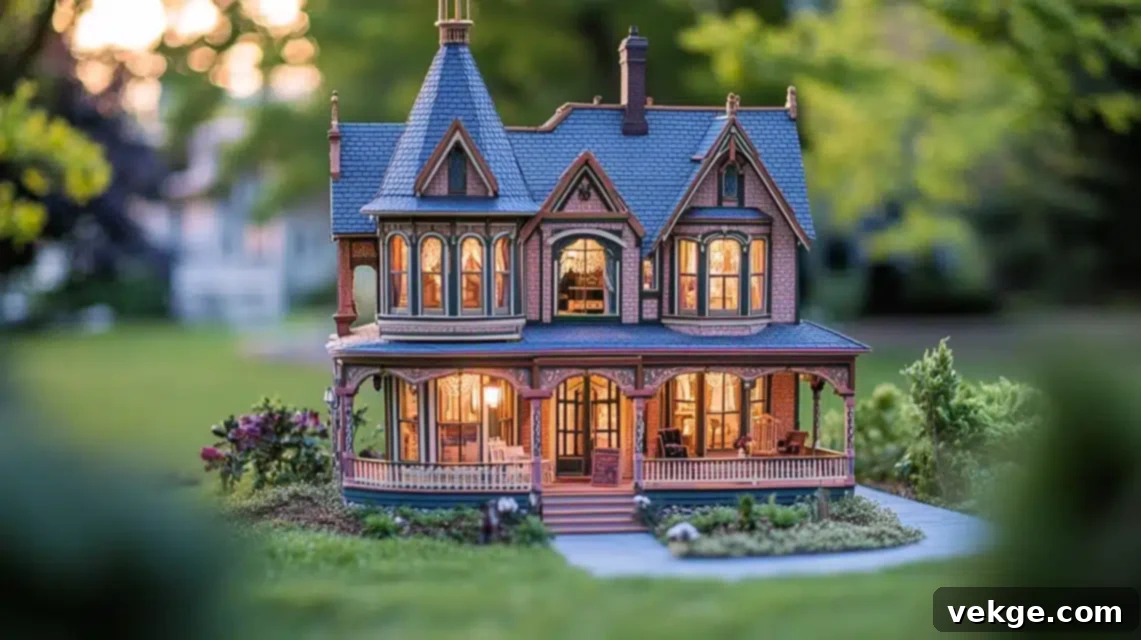
Stepping into the world of a Classic Victorian dollhouse is like opening a window to a bygone era of elegance and intricate beauty. These miniature mansions, with their elaborate details and stately presence, possess a timeless appeal that captivates across generations. Imagine the delicate charm of bay windows revealing miniature tea parties or grand family gatherings, perfectly preserved in exquisite detail. Every shingle, every carefully crafted spindle, and the delicate gingerbread trim narrate stories of architectural artistry. The steep roof peaks and inviting wraparound porches don’t just add to the aesthetic; they beckon imaginations to wander into a world of endless narratives, all bathed in the warm glow of sunlight streaming through meticulously placed, tiny windows, casting dollhouse-sized shadows across wallpapered rooms.
Crafting such a masterpiece requires a blend of precision and passion. Here’s a detailed DIY process to bring your Victorian dream to life:
- Build a robust foundation, raising the house proudly above its base for a grand presence.
- Craft sturdy walls, ensuring perfect plumb for multiple stories and structural integrity.
- Create an authentic roofline, meticulously matching true Victorian angles and features.
- Install interior walls, thoughtfully planning for future furnishings and room layouts.
- Add intricate architectural details to bring period authenticity, such as cornices and corbels.
- Design a detailed porch system, complete with delicate railings and decorative posts.
- Test all joints and connections rigorously, ensuring decades of imaginative play and durability.
- Apply period-correct colors and finishes, both inside and out, to capture the Victorian aesthetic.
- Install tiny hardware with precise placement, from doorknobs to window latches.
- Document your entire creative process for future projects or potential repairs.
2. Minimalist Modern Retreat
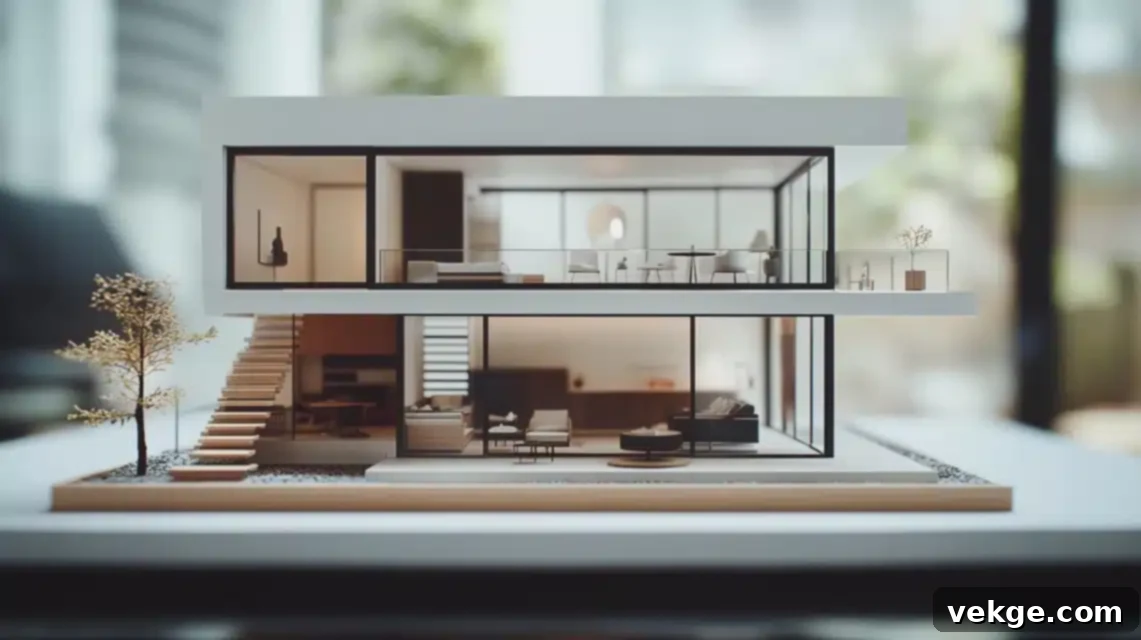
Imagine pristine white walls soaring upwards, meeting sleek, sharp angles where modern dreams take shape in miniature. This style celebrates simplicity, where less truly becomes more, and clean lines tell stories through the interplay of shadow and light rather than ornate details. Glass seamlessly meets wood in perfect harmony, as tiny sliding doors gracefully open to microscopic patios. Each carefully chosen material plays a pivotal role in this small-scale architectural narrative, from floating staircases that defy gravity to floor-to-ceiling windows that invite natural light to dance across polished miniature floors. The elegance lies in its understated sophistication and impeccable craftsmanship.
To construct a minimalist modern retreat, focus on precision and quality materials:
- Select high-quality materials, prioritizing smooth surfaces and clean finishes.
- Create perfect joints, which are absolutely essential for achieving a flawless modern aesthetic.
- Design a subtle lighting system that strategically highlights the clean lines and architectural features.
- Build custom furniture that perfectly matches the minimalist style and scale.
- Install microscopic sliding glass systems for windows and doors, ensuring smooth operation.
- Craft floating elements with cleverly hidden supports to maintain the illusion of weightlessness.
- Apply a refined finish, bringing subtle texture variations and depth to the surfaces.
- Plan strategic lighting placement to enhance mood and emphasize architectural elements.
- Consider sight lines through the open-concept layout to maximize visual spaciousness.
- Document material choices and finishing techniques for any future repairs or expansions.
3. Farmhouse Comfort Collection

Unlike the ornate Victorians or sleek modern builds, farmhouse dollhouses welcome you with an undeniable sense of warmth and rustic charm, characterized by worn wood and weathered whites. Imagine morning light gently catching tiny galvanized metal roofs, while miniature screen doors stand ready to squeak open in the imagination, inviting the smells of freshly baked miniature pies. Reclaimed barn wood, scaled down to create shiplap siding, tells stories through its unique grain patterns. Wraparound porches practically beg for miniature rocking chairs, and metal roof peaks shelter tiny families below. There’s a truly magical transformation that occurs when you add that first copper sink or slide a diminutive farmhouse table into its rightful place. These aren’t just dollhouses; they’re shrunken memories of grandma’s cozy kitchen, perfectly sized for endless storytelling.
To achieve this comforting aesthetic, here’s a guide to your farmhouse dollhouse construction:
- Weather new wood to create an authentic aged and worn appearance, embracing imperfections.
- Construct the roof, carefully allowing for metal panel overlap to mimic traditional farmhouse roofing.
- Design functional screen doors that swing open and shut, adding to the realistic charm.
- Create hand-scraped flooring boards, enhancing the rustic, lived-in feel.
- Build a quintessential farmhouse sink from shaped copper or a similar metallic material.
- Install tiny board and batten siding, a signature element of farmhouse architecture.
- Craft a screen porch complete with period-appropriate hardware for an inviting outdoor space.
- Age metalwork to develop an authentic patina, adding character and depth.
- Design working shutters, perfectly scaled to fit the windows.
- Document your aging and finishing techniques for consistency in future projects.
4. Whimsical Tree House Wonder
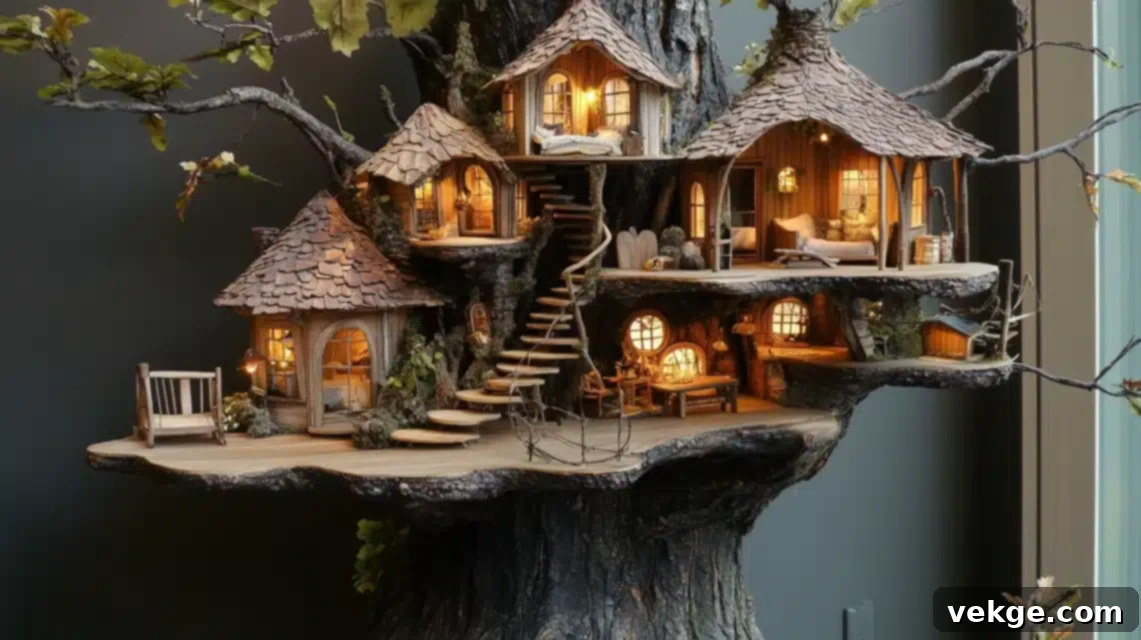
High above miniature forest floors, tiny rooms gracefully wrap around hand-carved tree trunks, evoking childhood dreams of secret hideaways and magical forest adventures. Spiral staircases wind charmingly between levels, while rope bridges sway gently beneath carefully crafted canopies. Each branch supports its own little world – perhaps a cozy sleeping loft here, a vigilant lookout tower there. Nature itself guides the design, with bark textures influencing wall patterns and leaf shapes inspiring unique window designs. This ensures that no two tree house dollhouses ever grow quite the same way, each becoming a unique testament to woodland whimsy and imaginative escape.
Bringing a whimsical tree house to life requires creativity and an eye for natural detail:
- Shape the main trunk, meticulously ensuring structural stability for the entire dwelling.
- Craft individual branch supports for multiple levels, making them appear organic and sturdy.
- Design removable roof sections for easy access to the interior for play or decoration.
- Create working rope bridges and ladders, adding interactive elements to the design.
- Build tiny furniture that perfectly fits the natural and whimsical themes of a treehouse.
- Install subtle LED lighting that mimics natural sunlight filtering through leaves.
- Construct platforms that allow a natural, gentle sway, enhancing the treehouse experience.
- Add realistic bark texture throughout the structure for an authentic woodland feel.
- Design safety rails that match the natural theme, ensuring both aesthetics and play safety.
- Document growth patterns and design choices for potential future expansions or additions.
5. Coastal Paradise Project
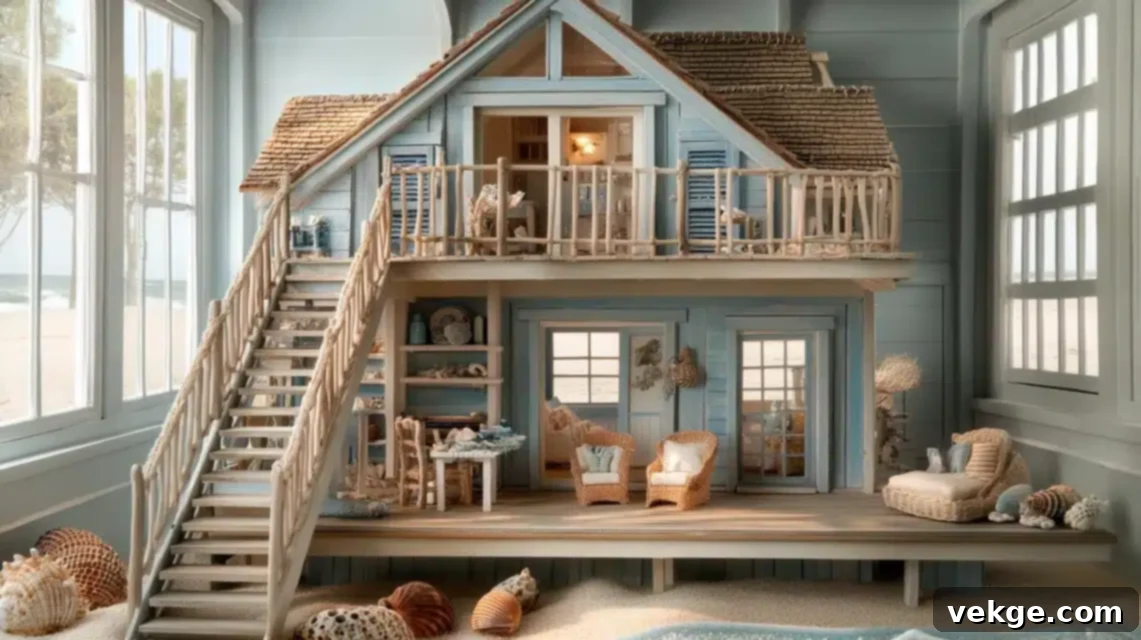
Salt-weathered shingles and driftwood decks whisper tales of imaginary seaside adventures, bringing the tranquility and beauty of the ocean indoors. Building these charming beach houses is all about capturing the essence of ocean breezes in miniature form. Expansive, floor-to-ceiling windows frame paper-thin horizons, while tiny shells and sea glass become perfectly scaled decorative elements, adding authentic seaside charm. Weathered dock wood, repurposed and transformed, creates wrap-around decks that host microscopic Adirondack chairs, inviting tiny inhabitants to relax and soak in the view. Watch the evening light play through carefully positioned windows, casting long shadows across sand-toned floors, all while tea-light-sized solar panels subtly power tiny pendant lights, embodying sustainable coastal living.
Creating your own coastal haven involves embracing natural textures and light:
- Weather cedar shingles meticulously for an authentic, sun-bleached coastal look.
- Build expansive windows, maximizing imaginary ocean views and inviting abundant natural light.
- Create multi-level deck systems using weathered wood to simulate a seaside structure.
- Design realistic dock attachments, adding functionality and a touch of realism.
- Craft functioning sliding glass doors, enhancing the open, airy feel of a beach house.
- Install mini solar lighting systems for a touch of eco-friendly realism.
- Build tiny outdoor shower enclosures, perfect for rinsing off after a miniature beach day.
- Create charming beach access walkways, leading to imaginary sandy shores.
- Design clever storage solutions for miniature beach equipment like tiny surfboards.
- Document your specific weathering techniques to ensure consistency across all elements.
6. Mid-Century Modern Magic
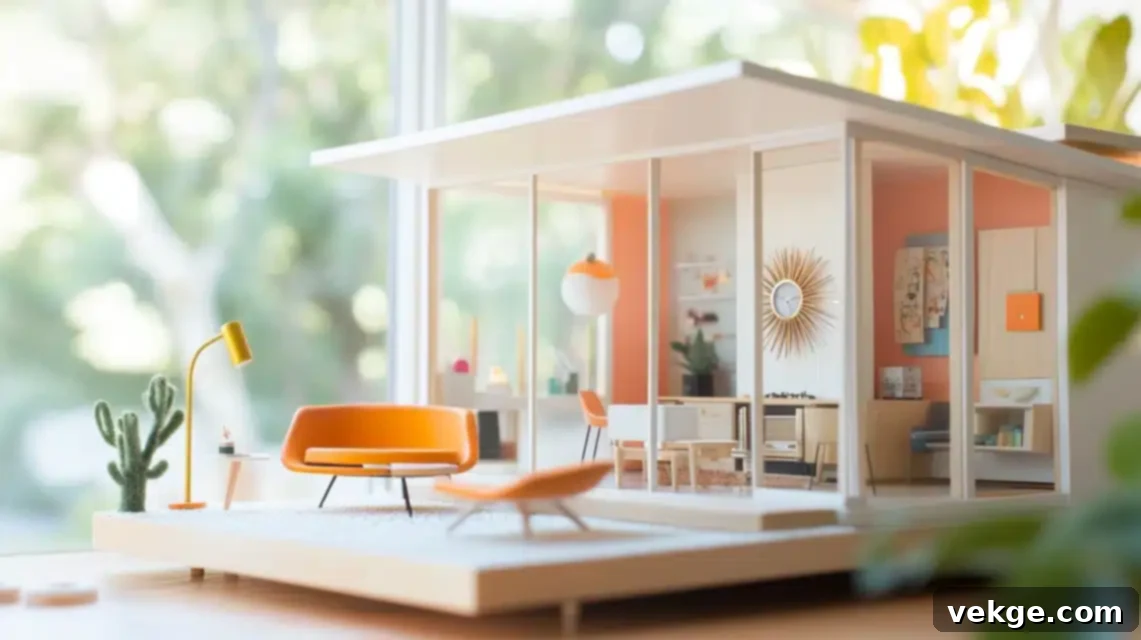
Here, sleek lines elegantly meet nostalgic design as yesterday’s architectural classics gracefully shrink to perfect miniature proportions. Clean angles frame iconic sunburst clocks, while tiny Eames-inspired chairs patiently await imaginative guests. Picture the warm afternoon light streaming through expansive floor-to-ceiling windows, casting dramatic shadows across beautifully walnut-veneered floors. Each room in a Mid-Century Modern dollhouse celebrates simplicity and functionality—from floating staircases that defy gravity to perfectly proportioned butterfly roofs reaching toward sky-blue ceilings. Danish-inspired furniture, meticulously hand-crafted to an exact scale, beautifully proves that sometimes, less truly does become more, creating a timeless and sophisticated miniature abode.
Achieving the distinctive Mid-Century Modern look demands precision and an understanding of the era’s design principles:
- Engineer precise angle cuts to create signature mid-century lines while maintaining structural integrity throughout the design.
- Create specialized joints that seamlessly connect modern elements, allowing for proper wood movement across seasons.
- Develop custom finishing techniques that accurately replicate period-correct wood tones and authentic materials.
- Construct scale-appropriate architectural details, meticulously matching authentic mid-century specifications and aesthetics.
- Design open-concept interiors that emphasize spaciousness and light flow.
- Incorporate iconic geometric patterns into miniature wallpaper or flooring.
- Build miniature versions of classic mid-century furniture with clean lines and tapered legs.
- Plan for integrated, subtle lighting to highlight the architectural forms.
- Choose a color palette of muted earth tones accented with bold, vibrant pops.
- Ensure all elements reflect a balance of functionality and aesthetic appeal.
7. Urban Apartment Complex
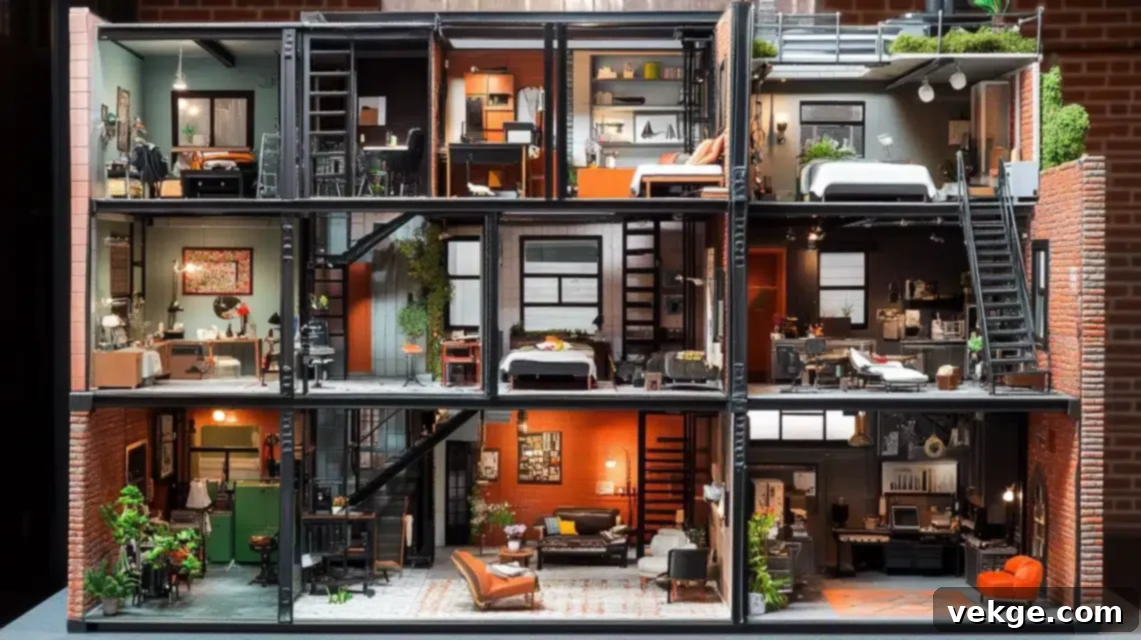
Tiny city living bursts into vibrant life through stacked stories and meticulously crafted shared spaces. Exploring a miniature apartment complex feels akin to wandering through a bustling urban neighborhood, with each individual unit narrating its own unique story. Exposed brick walls, expertly crafted from shaped clay, lend an authentic industrial charm to microscopic living spaces. Miniature fire escapes zigzag dramatically across facades, while verdant rooftop gardens provide a much-needed green sanctuary above the imagined busy streets below. Between units, shared corridors hold the promise of miniature metropolitan life, waiting for countless stories to unfold within their urban charm.
Building a multi-unit urban complex requires careful planning and a keen eye for city details:
- Begin with a sturdy structural grid system, ensuring perfect unit alignment and stability for multiple stories.
- Create individual and unique floor plans for each distinct apartment space, offering variety.
- Design working elevator shafts, complete with removable cars for easy maintenance and access.
- Install proper soundproofing materials between units, effectively using cork sheets or similar thin materials.
- Construct removable walls, allowing convenient access to each apartment for decorating and play.
- Build a fully functional fire escape system, including a proper support structure and intricate details.
- Design comprehensive rooftop garden infrastructure, incorporating miniature drainage systems.
- Create a basement parking garage complete with marked spaces and miniature vehicles.
- Install a working mailbox system in the lobby area for a realistic touch.
- Add security features, including tiny cameras and entry systems, for an authentic urban feel.
- Develop proper ventilation between floors using cleverly hidden channels.
- Create utility chase ways for realistic electrical and plumbing simulations.
- Design a proper trash disposal system, complete with chutes and miniature bins.
- Install a miniature intercom system at the main entrance.
- Document all unit layouts and complex systems for future reference and expansion.
8. Enchanted Castle Creation
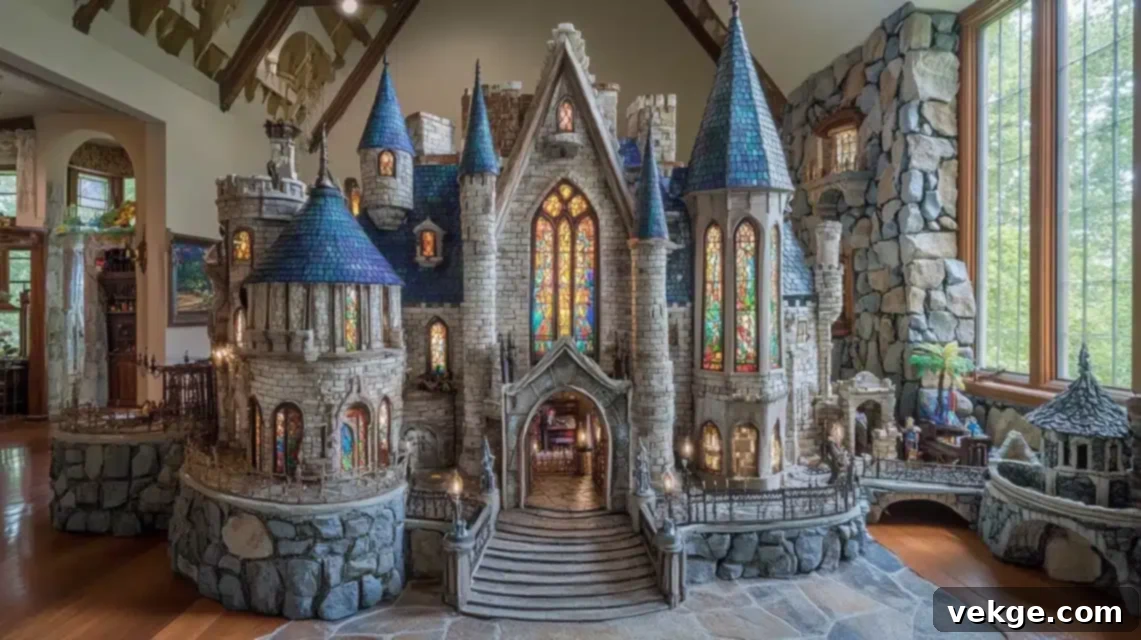
Towering spires majestically pierce imaginary clouds while hidden passages eagerly await discovery within the stone walls of an enchanted castle dollhouse. Each individual stone, meticulously carved from foam and textured by hand, contributes to the rich, medieval atmosphere rising proudly from its baseboard battlements. Stained glass windows, beautifully crafted from translucent resin, cast vibrant rainbow shadows across grand halls sized perfectly for tiny royal gatherings. Secret chambers cunningly reveal themselves through cleverly disguised panels, while working drawbridges span moats filled with mirrors, creating mesmerizing water illusions. This creation is more than a dollhouse; it’s a fortress of dreams and a stage for epic miniature sagas.
Constructing a detailed castle requires attention to historical elements and magical touches:
- Design a proper foundation capable of supporting multiple towers and heavy architectural elements.
- Create authentic stone texture using specialized foam carving techniques and realistic finishes.
- Build a working drawbridge mechanism, complete with tiny chains and a functional pulley system.
- Install hidden door mechanisms throughout the castle, adding an element of surprise and discovery.
- Construct intricate spiral staircases within each tower, offering access to different levels.
- Design a proper battlement system, complete with archer slots and crenellations for defense.
- Create stunning stained glass windows using resin techniques or colored cellophane.
- Install a working portcullis at the main entrance, adding to the medieval authenticity.
- Develop a proper drainage system for the courtyard, even if purely aesthetic.
- Build a secret passage network connecting various rooms and towers.
- Create a dungeon level with proper aging effects and miniature shackles.
- Install a lighting system that mimics flickering torch light and magical glows.
- Design an appropriate roofing system with a realistic slate texture.
- Add weathering effects to exterior stonework for an aged, ancient castle appearance.
- Document all secret passage locations and their opening mechanisms.
9. Bookshelf Integration
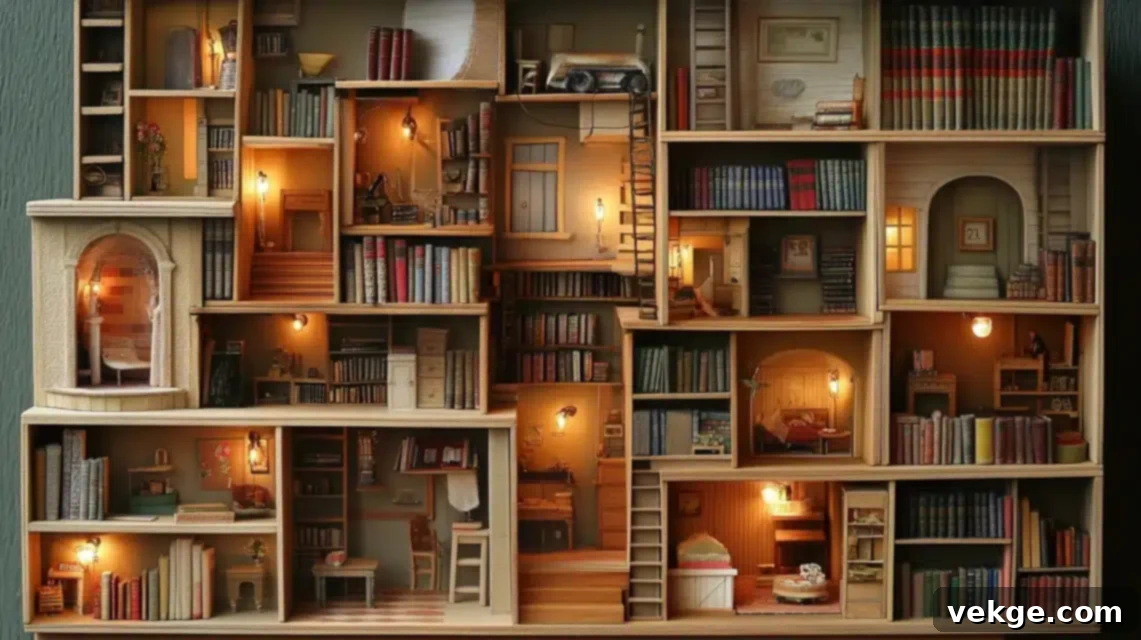
Transforming ordinary shelving into magical miniature worlds fundamentally changes how we perceive everyday furniture. Each shelf becomes its own captivating story level, with tiny, exquisitely detailed rooms nestled snugly between beloved books, creating unique literary-inspired living spaces. Hidden lighting artfully brings drama and warmth to otherwise forgotten corners, while carefully placed mirrors create enchanting illusions of endless space, adding depth and intrigue. In these designs, books transcend their traditional role, becoming architectural elements themselves—their spines forming walls and imaginative walkways between microscopic scenes. It’s a truly ingenious way to combine a love for literature with the joy of miniature crafting.
Integrating a dollhouse into a bookshelf requires clever design and spatial awareness:
- Measure existing shelf spaces precisely to allow for maximum room configuration and fit.
- Create modular room boxes that fit snugly and securely between books, making them interchangeable.
- Design a proper lighting system with hidden wiring to illuminate each miniature scene effectively.
- Build removable wall sections for easy access to the interior for decorating or rearranging.
- Construct miniature bookcases that match the full-size surroundings, blending seamlessly.
- Install mirror systems strategically to create stunning depth illusions and expand perceived space.
- Develop proper ventilation methods to prevent moisture buildup and protect delicate materials.
- Create hidden storage areas behind room boxes for miniature accessories or tools.
- Design proper dust protection systems, such as clear acrylic fronts, to keep scenes pristine.
- Build working drawer systems within shelf space for additional integrated storage.
- Add removable floor sections for easier maintenance and access to wiring.
- Install proper backing, preventing wall damage to the existing bookshelf.
- Create proper scale transitions and pathways between different rooms and levels.
- Design custom furniture specifically tailored for the unique depths and dimensions of shelf spaces.
- Document all electrical system locations and wiring diagrams for safety and future reference.
10. Sustainable Eco-Haven
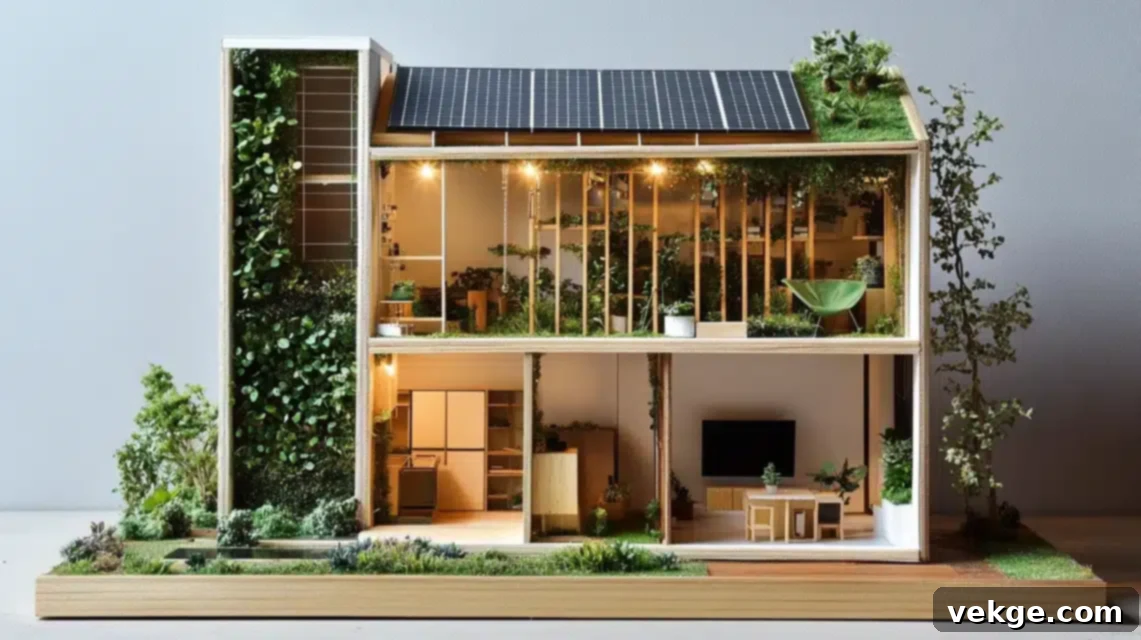
In this conscious creation, morning sunlight gently filters through tiny solar panels, while miniature rain barrels diligently collect imaginary droplets. Living walls burst with vibrant micro-succulents, transforming vertical spaces into dynamic green canvases that breathe life into every scaled-down corner. Recycled materials find ingenious new uses—yesterday’s copper wire becomes delicate stair railings, while bamboo toothpicks are cleverly transformed into perfect hardwood flooring. Observe how natural light gracefully plays through strategically placed windows, passively warming tiny spaces through smart solar design principles, creating a truly eco-friendly and inspiring miniature home that emphasizes harmony with nature and thoughtful resourcefulness.
Designing a sustainable eco-haven focuses on repurposed materials and smart environmental features:
- Begin with careful sustainable material selection, prioritizing reclaimed wood and eco-friendly adhesives for primary construction phases.
- Create a functioning rainwater collection system, including gutters, downspouts, and integrated storage within the structure’s design.
- Install a miniature solar panel array with a cleverly hidden wiring system connecting to LED lighting throughout each room space.
- Design and implement proper ventilation, utilizing natural airflow patterns through carefully placed windows and vents.
- Construct living wall infrastructure, ensuring proper moisture control and the long-term sustainability of miniature plants.
- Incorporate recycled materials creatively, such as small plastic caps for miniature planters or fabric scraps for upholstery.
- Design composting systems and tiny recycling bins for a complete eco-friendly lifestyle.
- Use natural dyes or paints for finishing, minimizing environmental impact.
- Plan for passive cooling and heating elements, like strategic window placement and thermal mass.
- Create a small, integrated garden plot for miniature herbs or vegetables.
11. Industrial Loft Living
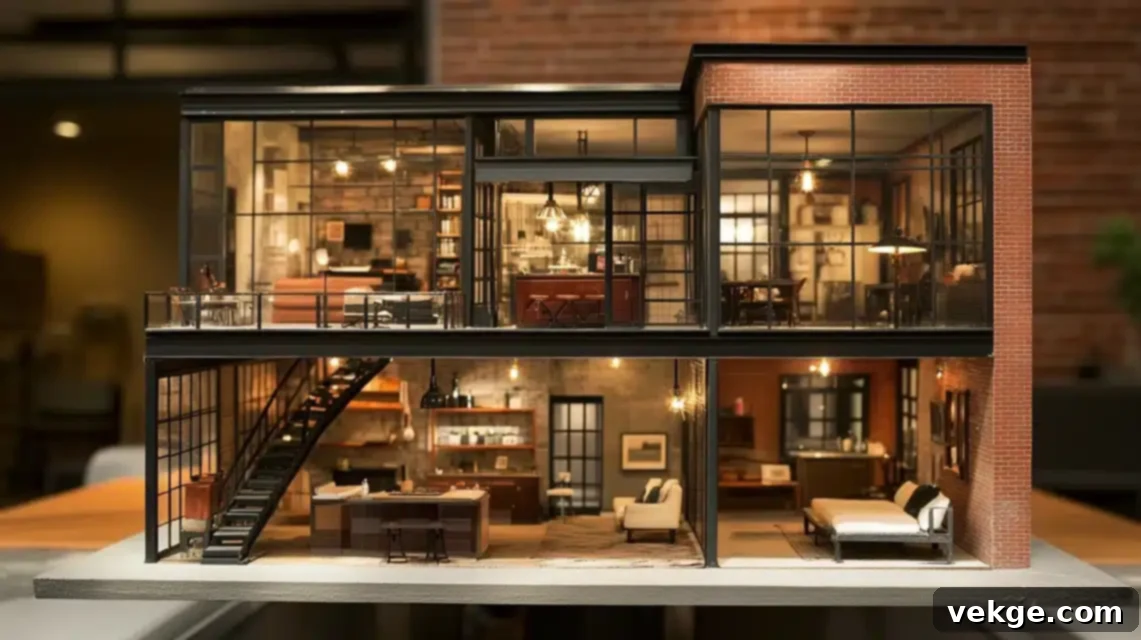
In this edgy design, exposed brick walls narrate captivating stories of imaginary factories and bustling urban history, while sleek steel beams gracefully trace paths overhead. Enormous factory windows, meticulously crafted from carefully cut plexiglass, flood open-concept spaces with an abundance of natural light, mimicking the spaciousness of real lofts. Miniature metal pipes transcend mere utility, becoming integral design elements that cleverly carry real LED wiring while perfectly matching the raw, industrial aesthetic. The hand-poured, polished concrete floor reflects the gentle glow of tiny pendant lights hanging from soaring ceilings, completing a sophisticated miniature world that celebrates urban chic and architectural transparency.
To master the industrial loft aesthetic, focus on raw materials and exposed elements:
- Build a foundational structure using a combination of wood and metal elements, ensuring proper support for industrial design features.
- Create authentic brick wall texture through specialized painting techniques and custom mold applications for realism.
- Develop a working track lighting system, cleverly concealed within an exposed metal beam network running throughout the ceiling space.
- Install polished concrete flooring using specialized micro-cement techniques, scaled perfectly for dollhouse dimensions.
- Design and construct rolling metal doors and industrial-style windows, complete with functioning hardware.
- Expose miniature ductwork and piping to enhance the factory-loft feel.
- Use a muted color palette with strategic pops of industrial colors like rust and deep blue.
- Craft minimalist furniture from metal, wood, and leather for an authentic touch.
- Integrate large, simple artwork or murals on walls to define spaces.
- Ensure ample natural light through large windows, a hallmark of industrial design.
12. Tiny House Revolution
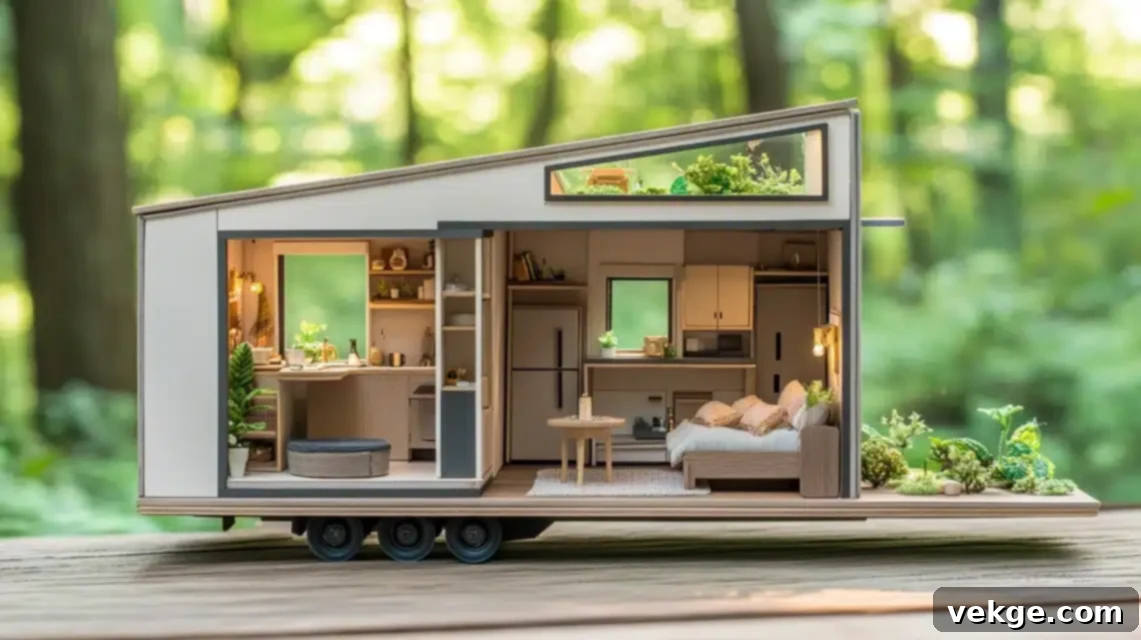
This scaled-down ode to simple living powerfully demonstrates that less can indeed be more, even in miniature form. Every precious inch within these tiny abodes serves multiple purposes – observe how miniature stairs ingeniously transform into hidden storage, while walls magically fold down to reveal tables or work surfaces. Creative storage solutions are cleverly tucked within walls barely thicker than a pencil, each space meticulously considered and maximized for efficiency. Murphy beds gracefully disappear into handcrafted walls, and mini skylights generously flood compact spaces with natural light, showcasing the ingenuity and charm of the tiny house revolution on a captivating, miniature scale.
Mastering the tiny house concept means maximizing every inch with clever, multi-functional designs:
- Create multi-functional furniture pieces that serve dual purposes through careful planning and precise mechanical construction.
- Design and implement hidden storage systems within wall cavities, utilizing sliding drawer mechanisms and secret compartments.
- Construct a working Murphy bed system with proper counterbalance, allowing smooth operation at a miniature scale.
- Build transforming furniture elements, including fold-down tables, retractable counters, and convertible seating arrangements.
- Install proper lighting schemes that maximize natural light through strategic window and skylight placement.
- Utilize vertical space with lofts and elevated sleeping areas.
- Incorporate miniature appliances designed for compact living.
- Ensure all design choices contribute to a sense of openness despite the small footprint.
- Prioritize lightweight materials for easier portability if the tiny house is on wheels.
- Document all clever mechanisms and hidden features for easy access and repair.
13. Geometric Dream Design

Unlike traditional dollhouses defined by right angles, this design daringly breaks free, creating a captivating interplay of shapes. Hexagons nest beautifully within triangles, while circles conjure unexpected and intriguing room formations. Every shape tells its own story – perhaps an octagonal meditation room here, a cozy triangular reading nook there. Light dances differently across these unconventional surfaces, creating fascinating shadow plays throughout the day as angled walls interact with shifting sunlight. Each geometric form flows seamlessly into the next, creating imaginative spaces that challenge traditional perceptions and invite creative exploration. Observe how sunset light creates stunning kaleidoscope patterns through carefully positioned windows of varying shapes, transforming the interior into an art piece.
Embarking on a geometric dream design requires meticulous planning and execution:
- Begin with precise geometric calculations, ensuring all shapes fit perfectly while maintaining proper scale relationships throughout the structure.
- Construct interconnected forms using specialized jigs and templates for consistent angle cuts and perfect shape formation.
- Design custom furniture pieces that perfectly match the geometric themes, ensuring functionality within unusual room shapes.
- Create specialized window installations that accommodate various geometric openings while maintaining weather-tight seals.
- Utilize contrasting colors and textures to emphasize individual geometric forms.
- Plan for strategic lighting to highlight the unique angles and shapes.
- Experiment with tessellations and repeated patterns in flooring and wall designs.
- Ensure structural integrity, as non-traditional angles can present unique engineering challenges.
- Document all measurements and angles precisely for future modifications or replication.
- Consider how light interacts with the various planes and surfaces to enhance visual interest.
14. Woodland Whimsy Cottage
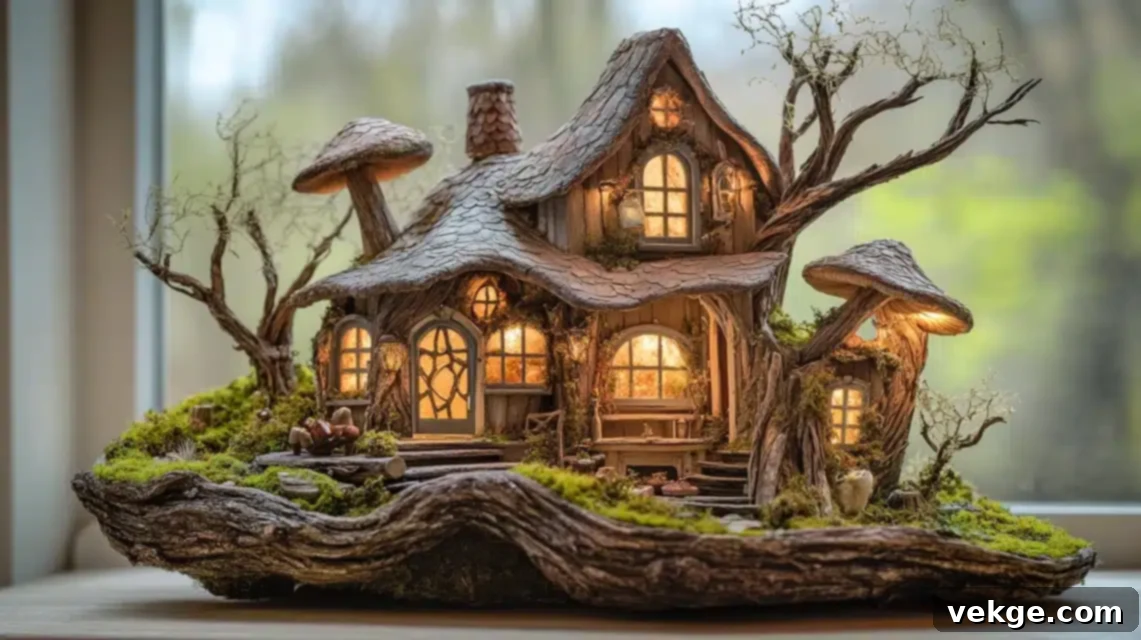
Deep within imaginary forests, mushroom caps ingeniously become charming rooftops, while twisted branches form perfect, organic window frames, inviting nature indoors. Here, nature guides every single design choice – bark textures inspire unique wall coverings, and moss-colored velvet transforms into lush, tiny carpeting. Rolling hills form the very foundation, with each level gracefully following natural contours. Miniature ferns delicately peek through floorboards, and enchanting fairy lights twinkle from hollowed knots in wooden walls. Nothing in this delightful cottage speaks of straight lines or sharp corners; instead, it embraces the organic flow of the forest. Imagine morning dew collecting on tiny, leaf-shaped shingles crafted from copper, destined to age beautifully into a verdant green patina.
To craft a truly whimsical woodland cottage, immerse yourself in natural forms and textures:
- Shape organic forms using foam base structures, carefully covered with natural textures, including real bark and preserved moss.
- Create curved window and door frames through steam-bending techniques, ensuring proper wood grain flow throughout the design.
- Develop a specialized lighting system mimicking natural forest patterns, including dappled sunlight effects and glowing mushrooms.
- Install living elements, such as miniature plants, while ensuring proper moisture control through hidden systems.
- Use natural materials like twigs, pebbles, and dried leaves for decorative accents.
- Design irregular, flowing pathways and steps that mimic forest trails.
- Incorporate hollowed-out log sections for rooms or storage.
- Create a soft, earthy color palette inspired by the forest floor.
- Build a miniature pond or stream with a tiny, working waterfall.
- Document your foraging and natural material preparation techniques.
15. Hinged Haven Creation

This ingenious masterpiece unfolds gracefully like a storybook, with each side revealing new, captivating chapters of tiny living spaces. Witness the enchantment in children’s eyes as hidden rooms magically appear with every gentle swing of carefully crafted, hinged doors. Proper hinge placement transforms what would be static displays into dynamic, interactive adventures. Central spaces remain easily accessible, while side rooms elegantly fold away, safeguarding delicate details when playtime concludes. Every wall serves a dual purpose—acting as a room divider on one side and an exterior facade on the other. Storage becomes beautifully simple when entire sections close securely, much like precious jewelry boxes, keeping everything tidy and protected.
Designing a hinged dollhouse requires precision engineering for smooth, transformative action:
- Design a comprehensive hinge system that properly supports weight distribution while allowing smooth operation through years of use.
- Create perfectly aligned walls, ensuring proper closure and maintaining consistent room depth throughout the structure.
- Establish hidden support structures to prevent warping or sagging when the house stands both open and closed.
- Develop specialized locking mechanisms that keep sections secure during play while allowing easy adult access for reconfiguration.
- Choose durable hinges that can withstand repeated opening and closing cycles.
- Incorporate finger-pulls or small knobs that are easy for little hands to operate.
- Plan the internal layout so that no furniture or accessories obstruct the folding mechanism.
- Ensure a stable base that prevents tipping when the house is fully extended.
- Document hinge types, placement, and any special assembly notes for future reference.
- Consider using magnets to help keep sections securely closed when not in use.
16. Schoolhouse Memories
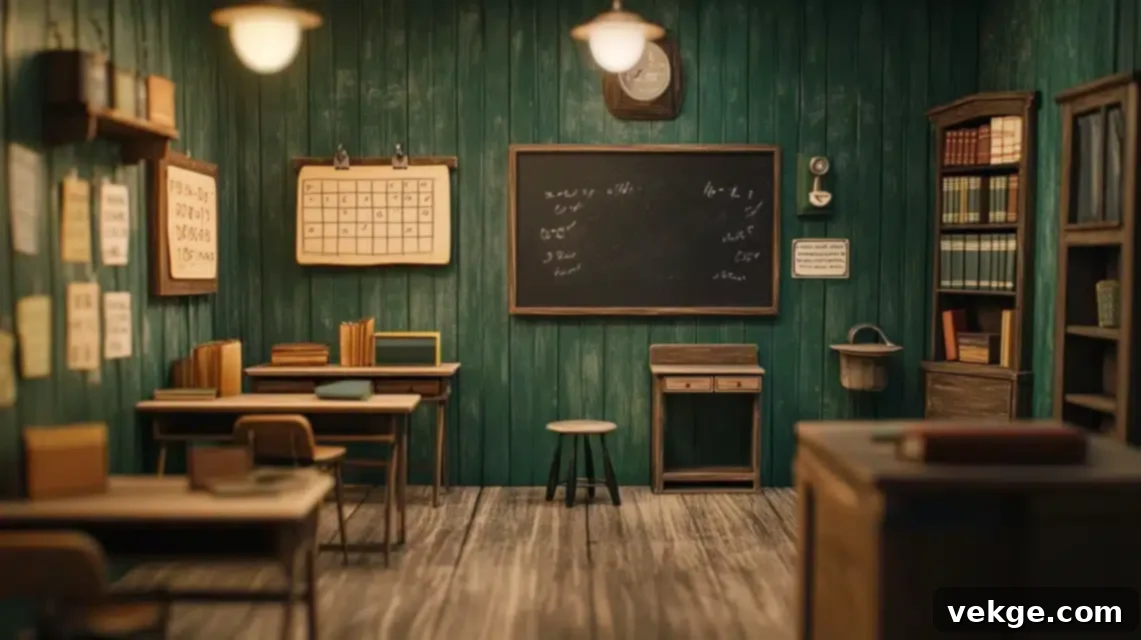
Step back in time with a charming schoolhouse dollhouse, where tiny bells hang poised above miniature coat hooks and perfectly scaled alphabet charts neatly line the classroom walls. Rows of diminutive desks, each thoughtfully carved with imaginary student doodles, face a green chalkboard still bearing faint chalk marks from a recent lesson. The library corner boasts handcrafted shelves brimming with books smaller than postage stamps, their tiny spines elegantly labeled with gold leaf. Outside, a scaled-down playground eagerly awaits, complete with swings that actually move and a sandbox filled with actual grains of sand, ready for miniature recess and endless educational adventures.
Recreating a schoolhouse requires a keen eye for historical detail and functional miniature elements:
- Create a functioning classroom bell system using miniature mechanical components and hidden spring mechanisms.
- Design a multi-functional classroom space with removable desk sections, allowing for varied room configurations.
- Construct working wall-mounted accessories, including fold-down maps and rotating chalkboards with proper counterbalance.
- Develop specialized sound absorption techniques mimicking authentic classroom acoustics for a realistic feel.
- Build miniature student lockers with working doors and tiny hooks.
- Design a miniature teacher’s desk with tiny drawers and a small lamp.
- Create a detailed miniature clock with moving hands for lesson timing.
- Install a scaled-down flagpole outside with a miniature flag.
- Craft tiny art supplies, including miniature paint pots and brushes.
- Document all functional mechanisms and movable parts for future maintenance.
17. Module Magic Marvel
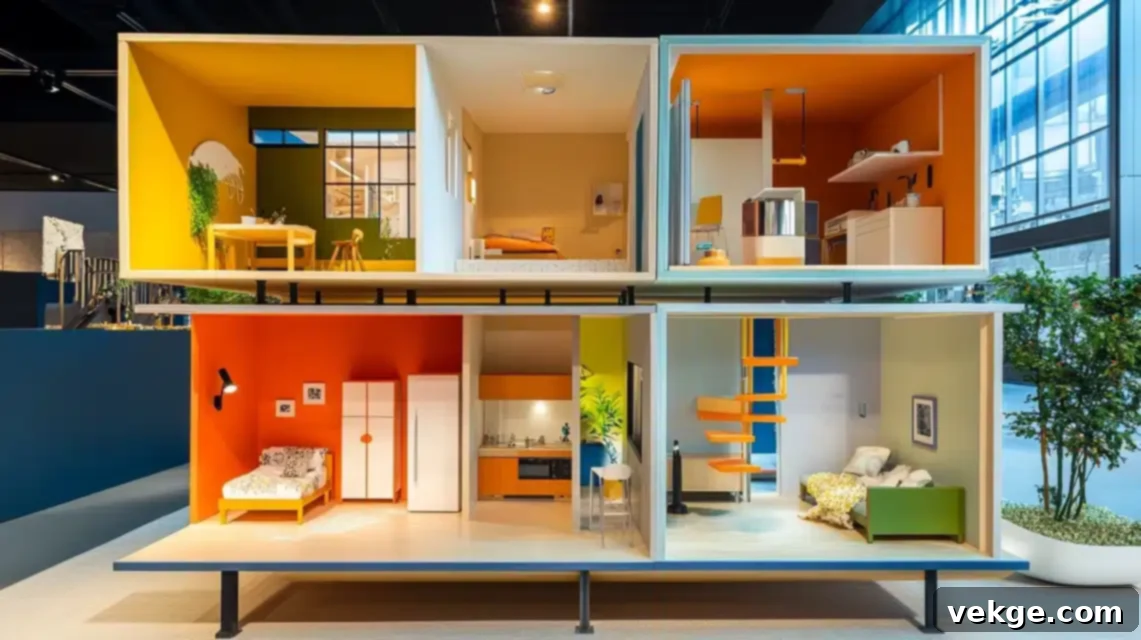
Like life-sized building blocks, these modular rooms can be endlessly rearranged, offering unparalleled flexibility and creative freedom. Yesterday’s cozy kitchen can effortlessly become today’s upstairs bedroom with a simple lift and turn, allowing for dynamic storytelling. Each module locks perfectly into its neighbors while proudly maintaining its independent character. Color-coded corners ensure precise alignment, while cleverly hidden magnets securely fasten connections, making reconfiguration smooth and satisfying. Staircases ingeniously adapt automatically as rooms shift positions, creating new pathways and surprising vistas through ever-changing spaces. Witness how different arrangements create unique light patterns as windows align unexpectedly, making every setup a fresh, new miniature experience.
Building a modular dollhouse emphasizes adaptability and innovative connection systems:
- Engineer a robust interlocking system allowing for secure connection while maintaining easy separation for reconfiguration.
- Create self-contained electrical systems with magnetic connectors, enabling safe and effortless power transfer between modules.
- Design universal trim pieces that can accommodate any room combination while maintaining a polished, finished appearance.
- Establish standardized dimensions for all modules, ensuring perfect alignment regardless of their arrangement.
- Develop lightweight yet sturdy construction techniques for easy handling of modules.
- Incorporate universal connectors for furniture, allowing pieces to be used in any room.
- Design modules with open fronts or removable back walls for easy access.
- Plan for a sturdy, level base that can support various module configurations.
- Consider a storage system for modules not currently in use.
- Document all module specifications, connection points, and electrical layouts.
18. Urban Loft Legacy
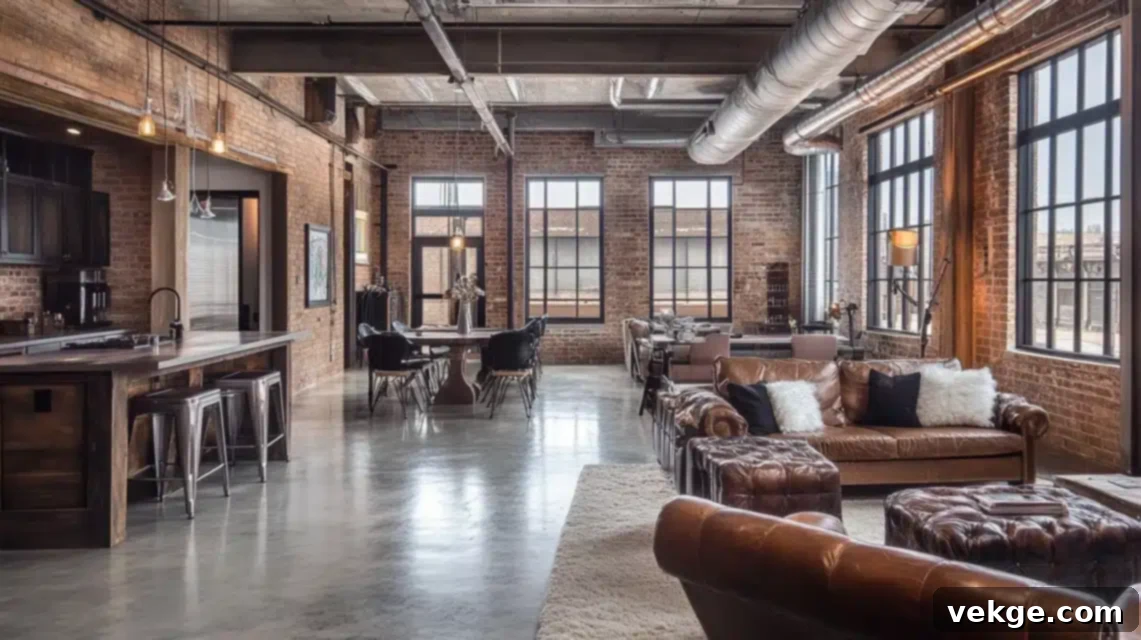
In the Urban Loft Legacy, brick walls wear their age proudly, each tiny clay piece meticulously hand-scored to reveal decades of imaginary weather and history. Steel beams, expertly crafted from aged aluminum, gracefully support soaring ceilings, while miniature copper pipes not only carry real LED wiring but also contribute significantly to the authentic industrial charm. Massive factory windows, salvaged from actual architectural models, generously flood open spaces with natural light, holding within them stories of miniature manufacturing past. Floorboards, stained to a perfect patina, subtly display wear patterns from countless tiny footsteps that were never taken, adding layers of narrative and depth to this sophisticated miniature urban dwelling.
To capture the authentic, aged aesthetic of an urban loft, focus on detailed weathering and exposed elements:
- Develop authentic brick aging techniques using specialized painting and texturing methods, creating a century-old appearance.
- Create exposed infrastructure systems, including functional ductwork and properly scaled industrial lighting fixtures.
- Design specialized window installation methods to accommodate oversized industrial-style openings and their unique framing.
- Construct custom finishing techniques that accurately replicate decades of wear and tear on all exposed surfaces.
- Source miniature industrial-style furniture, such as metal chairs and factory carts.
- Incorporate raw materials like concrete, steel, and exposed wood.
- Plan for high ceilings and open-concept layouts characteristic of lofts.
- Add miniature artwork with an urban or abstract theme.
- Utilize a muted, earthy color palette with metallic accents.
- Document all aging recipes and material sources for consistency.
19. Mansion Masterpiece
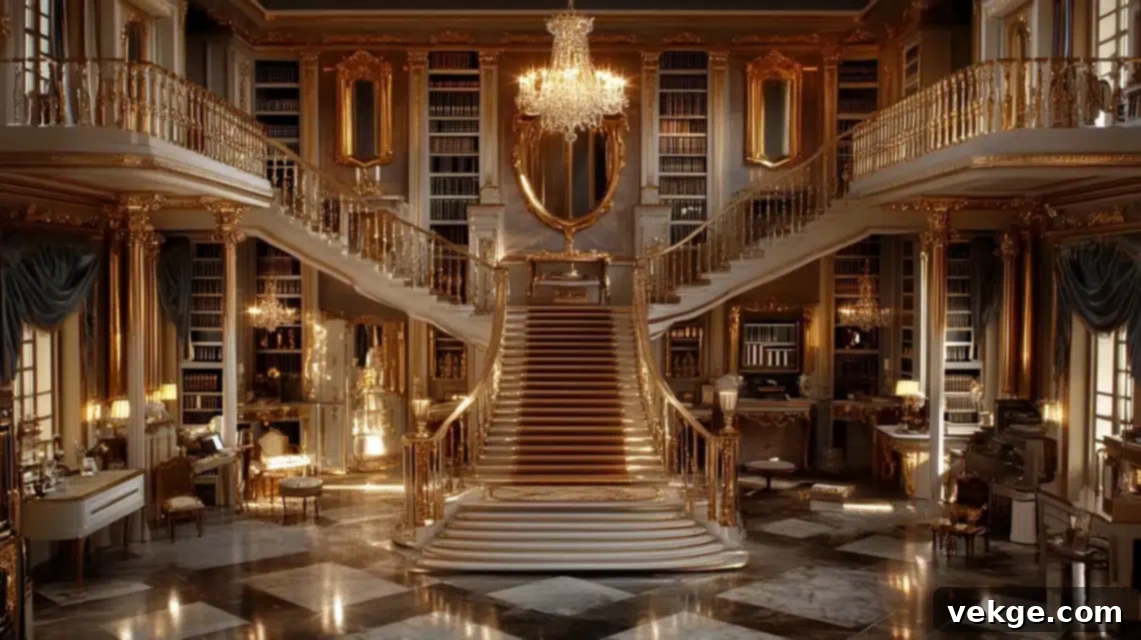
In this truly grand Mansion Masterpiece, opulence meets boundless imagination as sweeping staircases majestically spiral between perfectly proportioned parlors and elegant dining rooms. Exquisite crystal chandeliers, meticulously crafted from hand-cut glass beads, cast mesmerizing rainbow prisms across miniature marble floors made from carefully selected stone tiles. Hidden passages patiently wait behind library shelves filled with tiny volumes, while secret gardens bloom eternally in miniature conservatories, adding layers of mystery and enchantment. Grand ballrooms stand ready for tiny, elegant gatherings, their gilded mirrors multiplying spaces into an illusion of infinite grandeur, making every corner a testament to luxurious miniature living.
Crafting a mansion masterpiece demands meticulous planning and a flair for luxury and intricate detail:
- Create robust architectural support systems capable of accommodating multiple grand spaces while maintaining structural integrity.
- Design specialized lighting networks to elegantly highlight architectural features while providing practical illumination throughout.
- Construct working mechanical systems, including intricate elevator mechanisms and secret passage activation switches.
- Develop proper scale transitions between formal and private spaces, maintaining an authentic mansion flow and grandeur.
- Install miniature crown molding, wainscoting, and intricate ceiling medallions.
- Design formal gardens and landscaping elements outside, reflecting the mansion’s opulence.
- Source or create miniature high-end furniture, such as velvet sofas and antique desks.
- Incorporate luxurious materials like miniature silk drapes, oriental rugs, and crystal accessories.
- Plan for elaborate fireplaces in key rooms, complete with tiny mantels and hearths.
- Document all design choices and material sources for the ultimate heirloom piece.
20. Fantasy Mushroom Haven
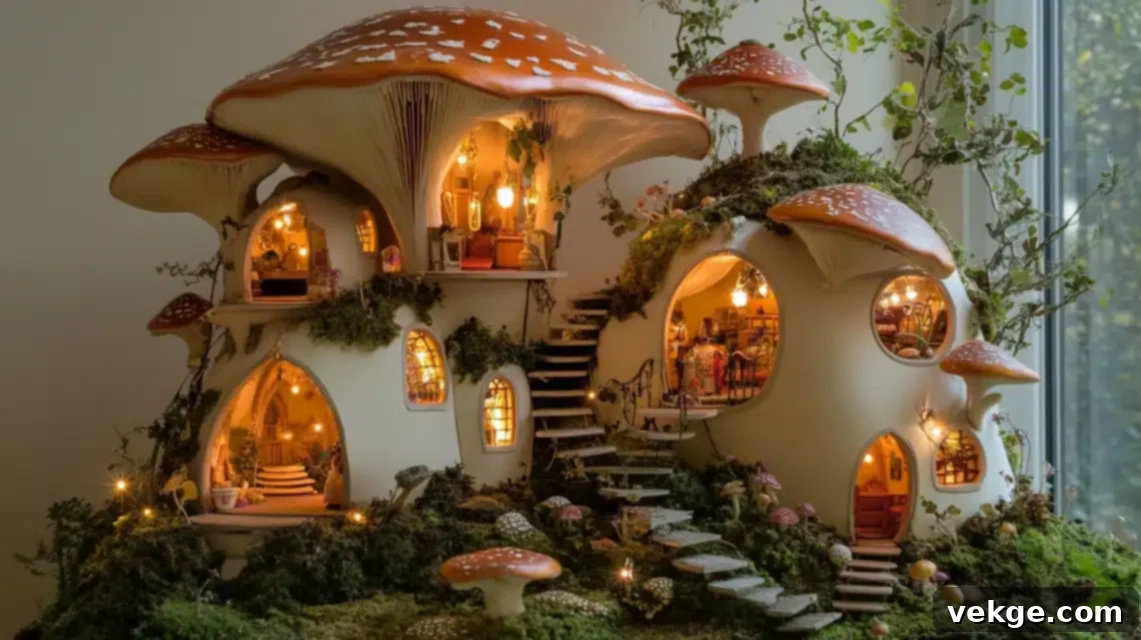
Unlike traditional dollhouses ruled by straight lines, in this Fantasy Mushroom Haven, curves gracefully dance and spirals joyfully sing. Massive mushroom caps, sculpted from lightweight foam and finished to a perfect, natural patina, provide whimsical shelter for rounded rooms below. Each window transforms into an organic portal—some shaped like delicate dewdrops, others mimicking intricate leaf patterns found in enchanted morning gardens. Stone pathways, crafted from tiny pebbles hand-selected for their color and unique shape, wind charmingly between levels, connected by spiral stairs wrapped around glowing crystal cores. Inside, floors follow natural contours while ceiling heights vary like enchanting cave formations, creating intimate, magical spaces that endlessly spark imagination. Observe how fiber optic strands, intricately woven through the structure like miniature mycelium networks, bring magical, bioluminescent lighting to every hidden corner, making this a truly unique and mystical dwelling.
Building a fantasy mushroom haven is a creative journey into organic forms and magical effects:
- Shape structural foam elements to create organic mushroom forms while ensuring proper support through internal armature systems.
- Develop specialized coating techniques, transforming basic materials into believable fantasy surfaces using layered finishes and natural textures.
- Create integrated lighting systems mimicking bioluminescent effects through a clever combination of fiber optics and LED technologies.
- Design proper ventilation, maintaining material integrity while supporting glowing elements and delicate electronic components.
- Craft curved doors and windows that follow the natural lines of the mushroom caps.
- Incorporate miniature plant life, such as mosses and tiny ferns, into the design.
- Build winding pathways and ramps instead of straight stairs.
- Use glowing elements or translucent materials to enhance the magical atmosphere.
- Create unique, fantasy-themed miniature furniture from natural elements.
- Document all fantastical design choices and material specifications.
21. Gingerbread Dream House
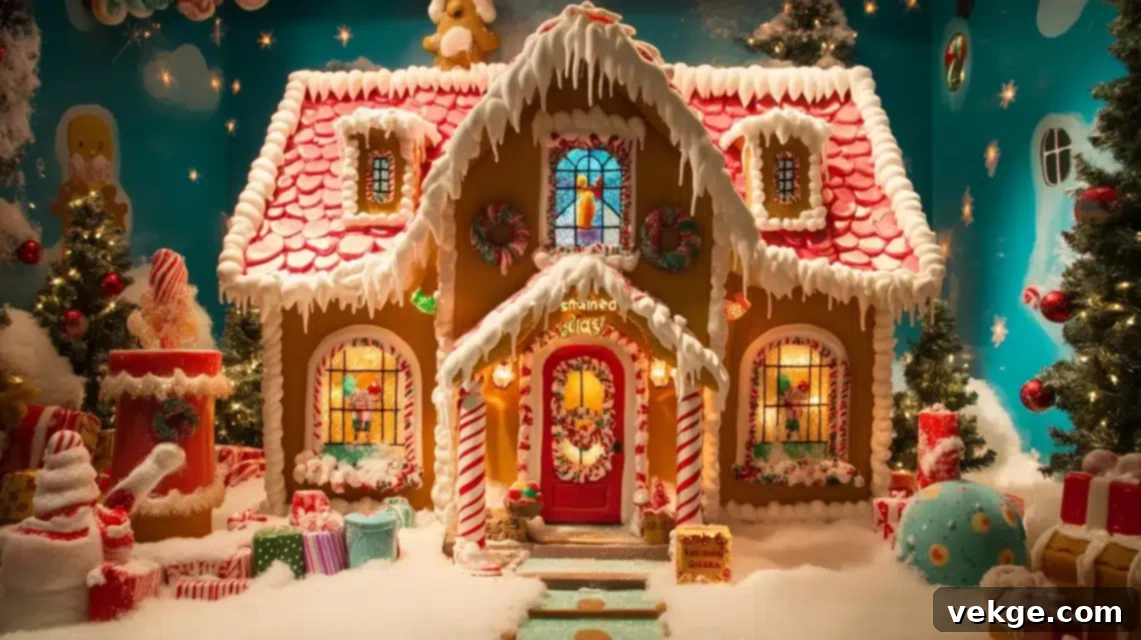
Unlike traditional dollhouses, this confectionery creation truly comes alive through an array of delectable architectural candy elements. Carefully molded “icing” trim, artfully crafted from specialized modeling compounds, creates intricate Victorian scrollwork that looks deliciously good enough to eat. Stained glass windows, cleverly made from melted candies or translucent resin, cast vibrant, colorful shadows across the rooms, infusing every corner with sweet charm and a whimsical glow. Peppermint stick columns provide sturdy yet charming support for delicate balconies where miniature gummy bears might gather for an imaginary afternoon tea. This dollhouse is a feast for the eyes and a delightful celebration of sugary architectural imagination.
Crafting a gingerbread dream house involves specialized techniques to simulate edible aesthetics with durable materials:
- Develop a specialized weatherproof coating system to protect decorative elements while maintaining a realistic candy-like appearance throughout seasons.
- Create textured surfaces mimicking various confections, using custom-mixed compounds and detailed mold-making techniques.
- Design a proper support structure, ensuring stability while accommodating decorative candy-style architectural features.
- Construct specialized ventilation to prevent moisture buildup behind sweet-inspired facade elements.
- Use colorful, translucent materials for windows to simulate melted hard candies.
- Craft miniature candies, gumdrops, and sprinkles for decorative accents.
- Build structural elements that resemble gingerbread cookies, complete with etched details.
- Design a sugary landscape around the house with miniature lollipop trees and candy fences.
- Ensure all materials are non-toxic and durable for long-term enjoyment.
- Document all custom compound recipes and decorative application methods.
22. Cardboard Conversion Castle
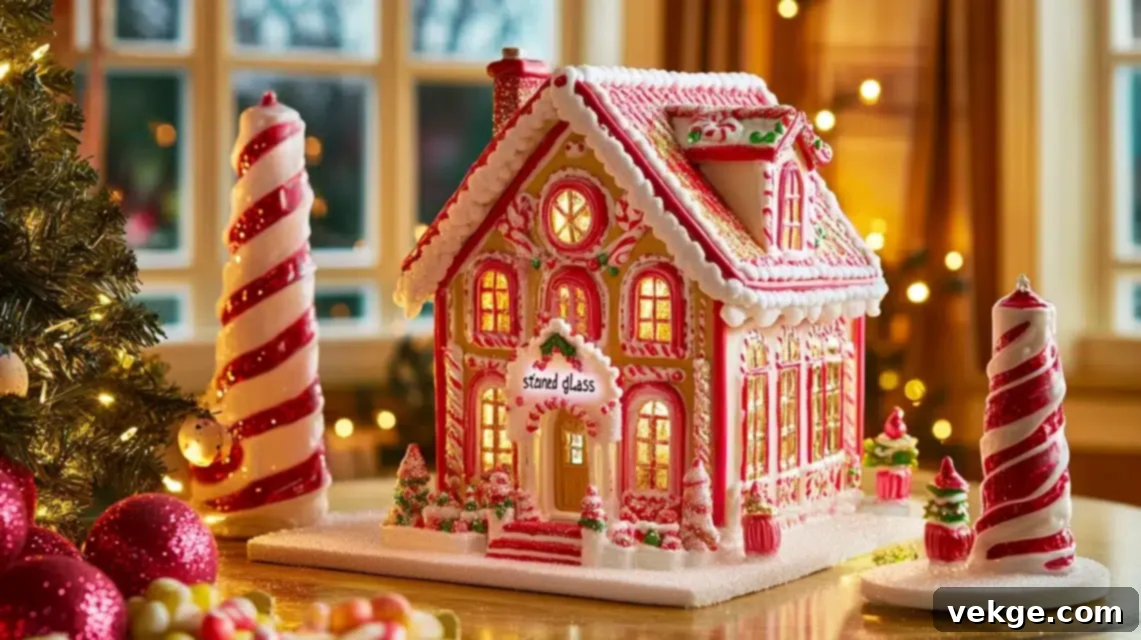
Witness the remarkable transformation as yesterday’s humble shipping boxes evolve into tomorrow’s architectural wonders through careful engineering and boundless creativity. Every fold in a cardboard conversion castle becomes an opportunity: double-thick walls cleverly provide hidden storage compartments, while corrugated layers impart unexpected strength and rigidity to the structure. Observe how strategic scoring creates perfectly crisp corners, and layered cardboard builds dimensional details that impressively rival traditional wooden trim. Simple, readily available materials tell complex and captivating stories as ordinary boxes are ingeniously repurposed into extraordinary living spaces, proving that imaginative design is not limited by cost or material.
Building a robust cardboard castle requires understanding the material’s properties and applying smart construction techniques:
- Establish specialized cutting and scoring techniques, maximizing cardboard’s structural potential while ensuring long-term stability.
- Create weatherproof exterior treatments, protecting the cardboard structure while maintaining the material’s natural texture characteristics.
- Design interlocking wall systems, utilizing cardboard’s inherent properties for creating strong yet lightweight construction.
- Develop proper moisture barriers, preventing atmospheric damage while allowing the material to breathe.
- Reinforce key structural points with additional layers of cardboard or craft sticks.
- Use strong, quick-drying adhesives suitable for cardboard construction.
- Craft textured surfaces, such as stone or wood, using paint and additional cardboard layers.
- Design movable parts like drawbridges and portcullises that operate smoothly.
- Incorporate hidden compartments and secret passages within the cardboard walls.
- Document all cutting templates and assembly steps for precise construction.
23. Portable Paradise Project
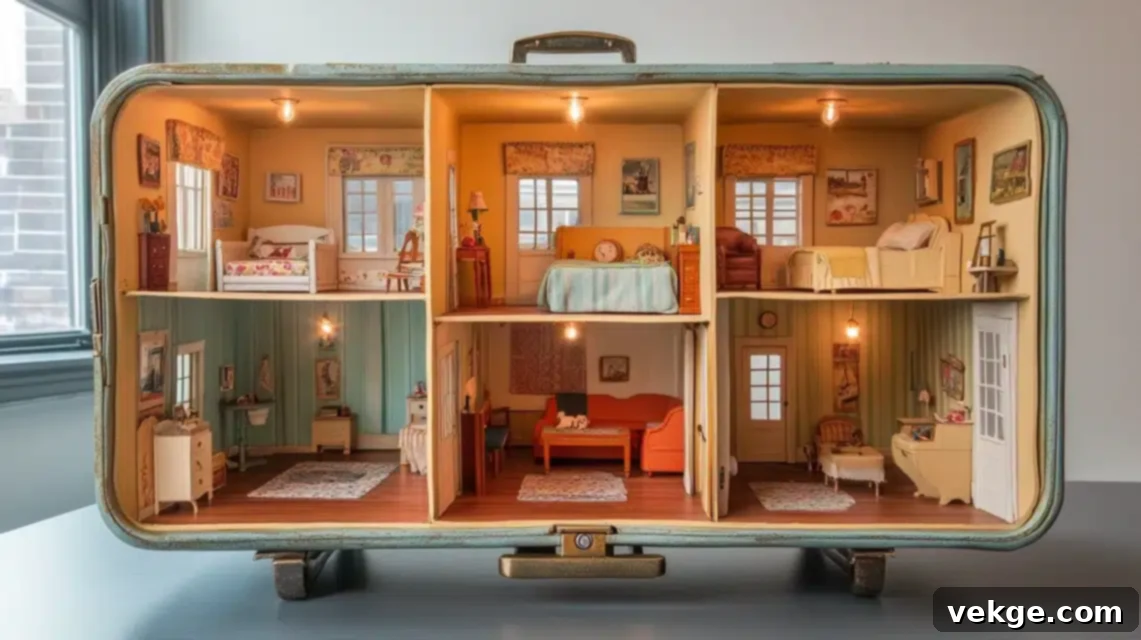
This ingenious traveling dollhouse gracefully packs decades of charm and endless play possibilities into the compact dimensions of a vintage suitcase. Its walls fold away like intricate origami, revealing fully furnished rooms while miraculously maintaining perfect scale throughout the transformation. Hidden compartments ingeniously spring to life, each one safeguarding miniature treasures eagerly waiting to be discovered by small hands. Observe how clever engineering allows entire miniature neighborhoods to emerge from seemingly ordinary luggage, transforming any location into an instant playtime paradise. It’s the ultimate dollhouse for adventurers, ensuring that miniature worlds can accompany imaginations wherever they go, offering portability without compromising detail or enchantment.
Creating a portable paradise requires smart design that balances compactness with detailed playability:
- Engineer specialized folding mechanisms, ensuring smooth operation while protecting delicate interior elements during transit.
- Create multi-functional spaces that skillfully adapt between travel and display configurations without compromising design integrity.
- Construct protective systems, preventing damage during transport while maintaining easy access for play.
- Design specialized storage solutions that efficiently accommodate furniture and accessories within limited suitcase dimensions.
- Use lightweight yet durable materials for the main structure.
- Secure all furniture and decorative elements to prevent movement during travel.
- Incorporate magnets or small latches to hold sections securely in place when opened and closed.
- Design a comfortable carrying handle and reinforce the suitcase structure.
- Plan for interchangeable backdrops or removable wall sections for diverse play scenarios.
- Document the packing sequence and ideal placement of all miniature items.
24. Log Cabin Chronicles
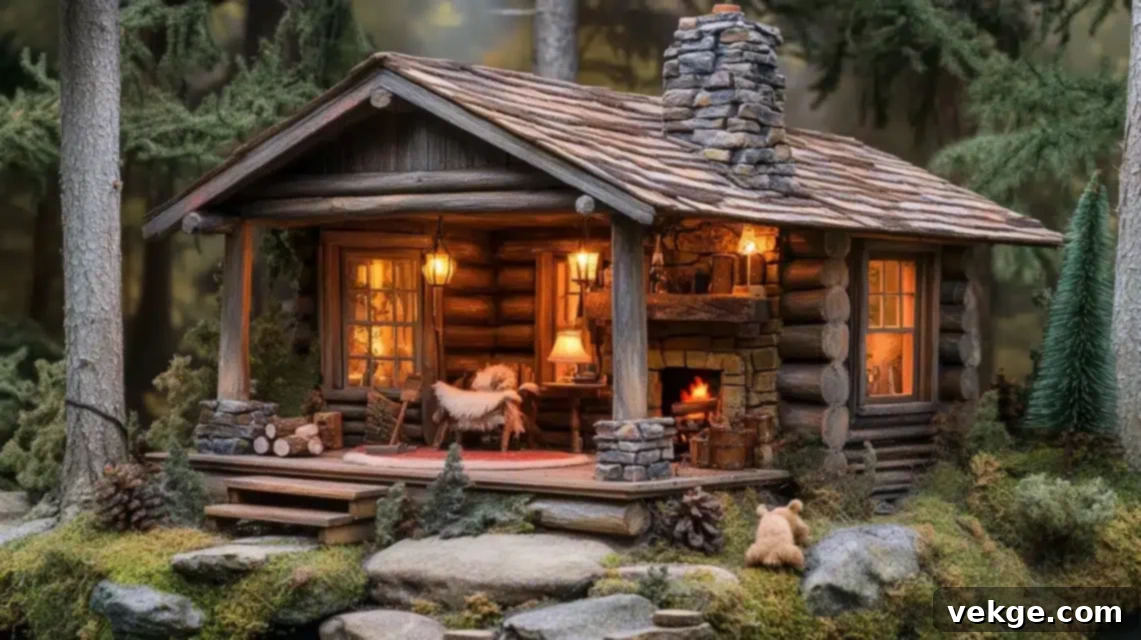
Tiny logs, each meticulously hand-scored to reveal years of imaginary weathering, stack perfectly to form rustic wilderness retreats. Stone fireplaces, painstakingly built from carefully selected miniature pebbles, stand ready for microscopic marshmallow roasting, radiating a cozy, inviting warmth. Observe how evening LED lights gently flicker through the windows, casting warm, inviting glows across miniature bearskin rugs, creating an idyllic scene of rustic comfort. Outside, the finished wood ages naturally, faithfully protecting countless stories and cherished memories within its charming, resilient walls, making this a true testament to the enduring appeal of wilderness living, miniaturized.
Building a log cabin requires attention to natural textures and rustic details:
- Create a specialized wood aging system, replicating decades of natural weathering while ensuring structural integrity.
- Design working fireplace features, including hidden lighting and subtle smoke effects using controlled vapor systems.
- Develop proper chinking techniques, sealing between logs while maintaining an authentic, rustic appearance.
- Construct outdoor living spaces, seamlessly integrating naturally found materials with crafted elements.
- Source or create miniature log-style furniture and rustic decor.
- Design a miniature porch or deck with tiny wooden benches.
- Install small, multi-pane windows typical of log cabins.
- Use natural materials for landscaping, such as miniature trees and rocks.
- Plan for a cozy, warm interior lighting scheme.
- Document the source and treatment of all natural materials used.
25. Fairytale Forest Dwelling
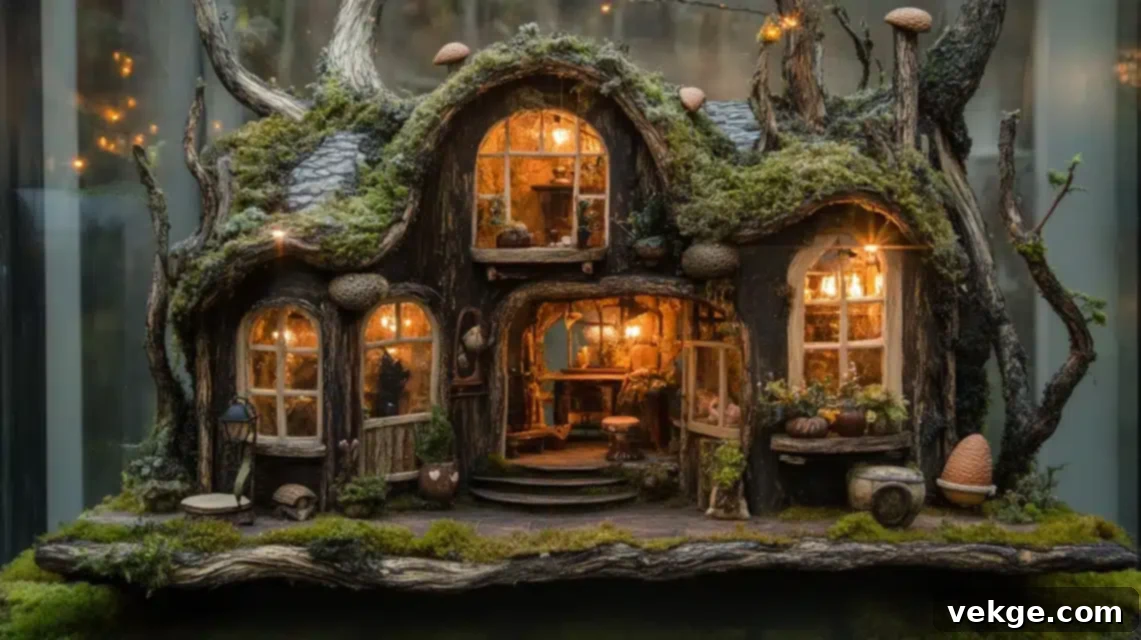
Where boundless whimsy magically converges with exquisite woodworking, true enchantment happens in miniature form. Twisted branches organically transform into charming doorways, while delicate acorn caps become perfect, sparkling fairy light fixtures, illuminating hidden corners. Miniature gardens gracefully spiral upward on tiny trellises, and lush mushroom caps provide whimsical shelter for imagination’s smallest residents. Imagine morning dew shimmering on gossamer wings, delicately crafted from iridescent film, adding an ethereal touch to this magical abode. Every element in this fairytale dwelling is designed to ignite wonder, creating a captivating world where anything is possible, and dreams take miniature flight, inviting endless stories and adventures.
Creating a fairytale forest dwelling is about bringing fantastical elements to life with a natural touch:
- Shape organic materials, creating a natural flow while ensuring structural stability through hidden support systems.
- Create specialized lighting effects mimicking magical elements, using fiber optics and LED technology for enchanting glows.
- Design proper ventilation, maintaining a delicate balance between whimsy and practical preservation of materials.
- Construct integrated garden features that can support living miniature plants within the fantasy setting.
- Use natural elements like twigs, moss, and bark for walls, roofs, and decorative accents.
- Design irregular, whimsical windows and doors that look like they grew organically.
- Incorporate miniature fairy figures, enchanted animals, and sparkling elements.
- Build winding pathways of tiny pebbles or moss leading to the dwelling.
- Plan for a soft, magical color palette using natural tones and shimmering accents.
- Document all fantastical elements and their construction methods.
Final Thoughts on Crafting Your Dream Dollhouse
Beyond their tiny walls, every dollhouse holds a universe of stories, waiting for hands both big and small to bring them to life. Through careful crafting, meticulous attention to detail, and a touch of personal flair, we create far more than just miniature buildings – we construct vessels for boundless imagination. Each project, whether a simple cottage or an elaborate mansion, becomes a cherished narrative, a tangible piece of a dream.
Remember, true perfection in dollhouse creation often blossoms from beautiful imperfections. Those tiny gaps, the slightly worn edges, or the unique twist in a miniature branch? These aren’t mistakes; they are character, waiting to be discovered and celebrated by small, curious fingers and expansive, imaginative minds. They add depth and history to your miniature world, making it truly unique.
Whether you’re embarking on your very first cardboard creation, a heartfelt DIY dollhouse project, or meticulously engineering a multi-story mansion, each endeavor contributes to the magical, ever-expanding world of miniatures. So, keep building, keep dreaming, and most importantly, keep sharing the profound joy these tiny spaces bring to both the young and the young at heart. After all, in the enchanting world of dollhouses, even the smallest details hold the biggest, most enduring stories.
Frequently Asked Questions About Dollhouse Creation
Is This Style Suitable for Beginners?
For those new to crafting fantastical or organic dollhouses, it’s often best to start with simpler, rounded forms before tackling complex mushroom shapes. Basic dome structures can effectively teach essential curved surface techniques and build confidence. My personal recommendation for a first fantasy build is to focus on a single-level design, mastering the fundamentals before gradually expanding upwards with more intricate designs.
What Materials Work Best for Organic Shapes?
Extruded polystyrene foam provides excellent shaping possibilities, offering both flexibility and structural integrity for organic forms. For achieving truly natural appearances, you can effectively cover the foam with paper clay or various textured coatings. For smaller, more delicate detailed elements, consider using lightweight air-dry clays, which allow for fine sculpting and intricate finishing.
How Do You Maintain Delicate Features?
The key to maintaining delicate features lies in designing protective elements directly into the structure itself. For instance, creating deeper window wells helps shield miniature glass, while slightly recessed doors can prevent accidental damage. Additionally, designing removable sections for easier access significantly simplifies maintenance. Regular, gentle dusting with a soft brush is crucial for preserving detailed surfaces and keeping your miniature world pristine.
What’s the Best Scale for Fantasy Designs?
While the traditional 1:12 scale works perfectly well for many dollhouse styles, flexible scaling often provides more creative freedom and benefits fantasy builds significantly. Allowing your imagination to guide size relationships—for example, making mushroom homes particularly suit whimsical proportion play—can lead to unique and captivating results. The most important aspect is to maintain a consistent scale within each distinct section of your dollhouse to ensure a cohesive and believable miniature world.
How Do You Plan Organic Shapes?
To effectively plan organic shapes, begin by creating clay models or rough sketches, allowing you to explore various forms before committing to final materials. It’s also highly beneficial to photograph inspiration directly from nature walks, studying real mushroom growth patterns, twisted branches, or rock formations for authentic details. Remember that natural shapes often follow hidden, underlying patterns; understanding these can greatly enhance the realism and charm of your miniature organic designs.
